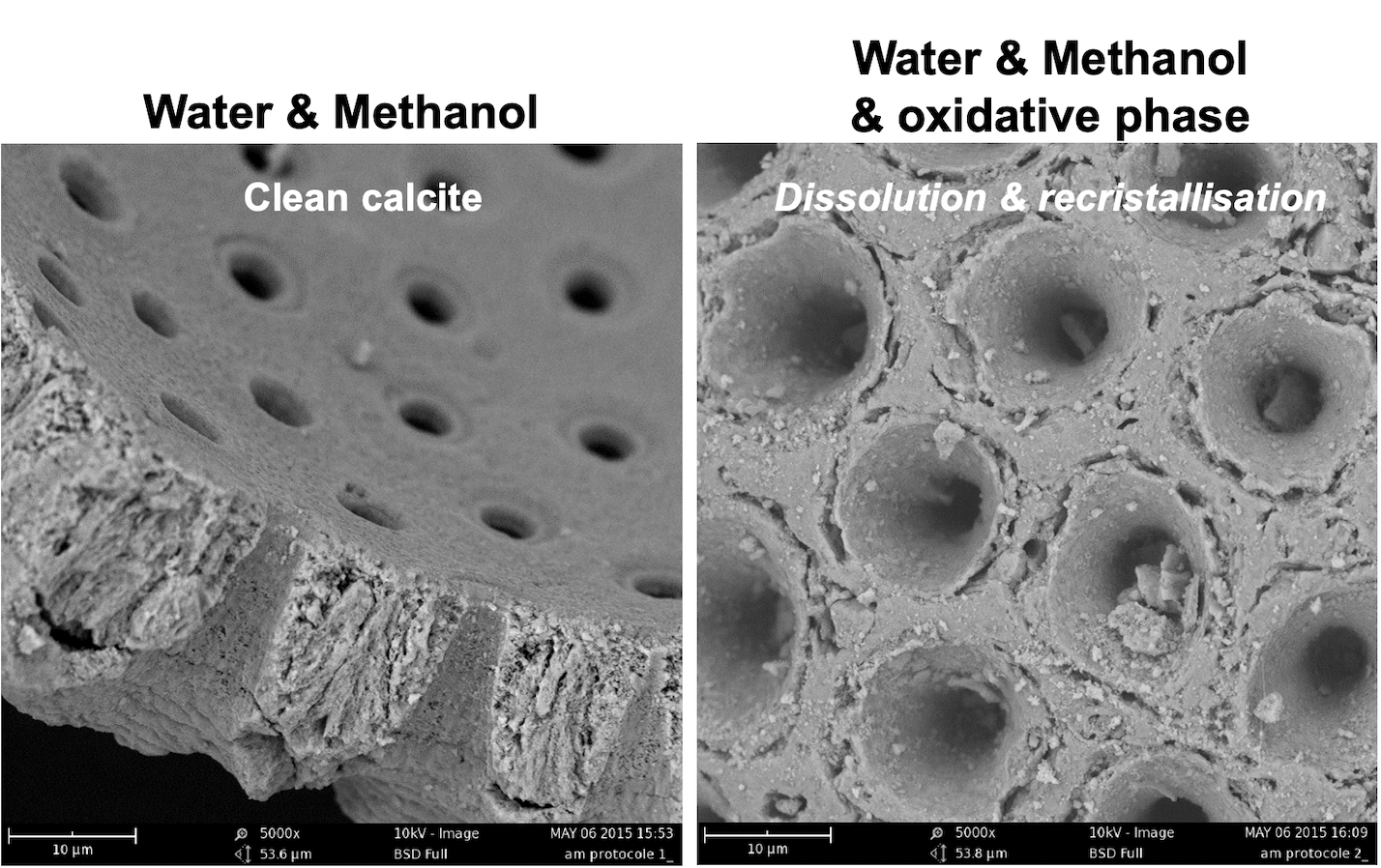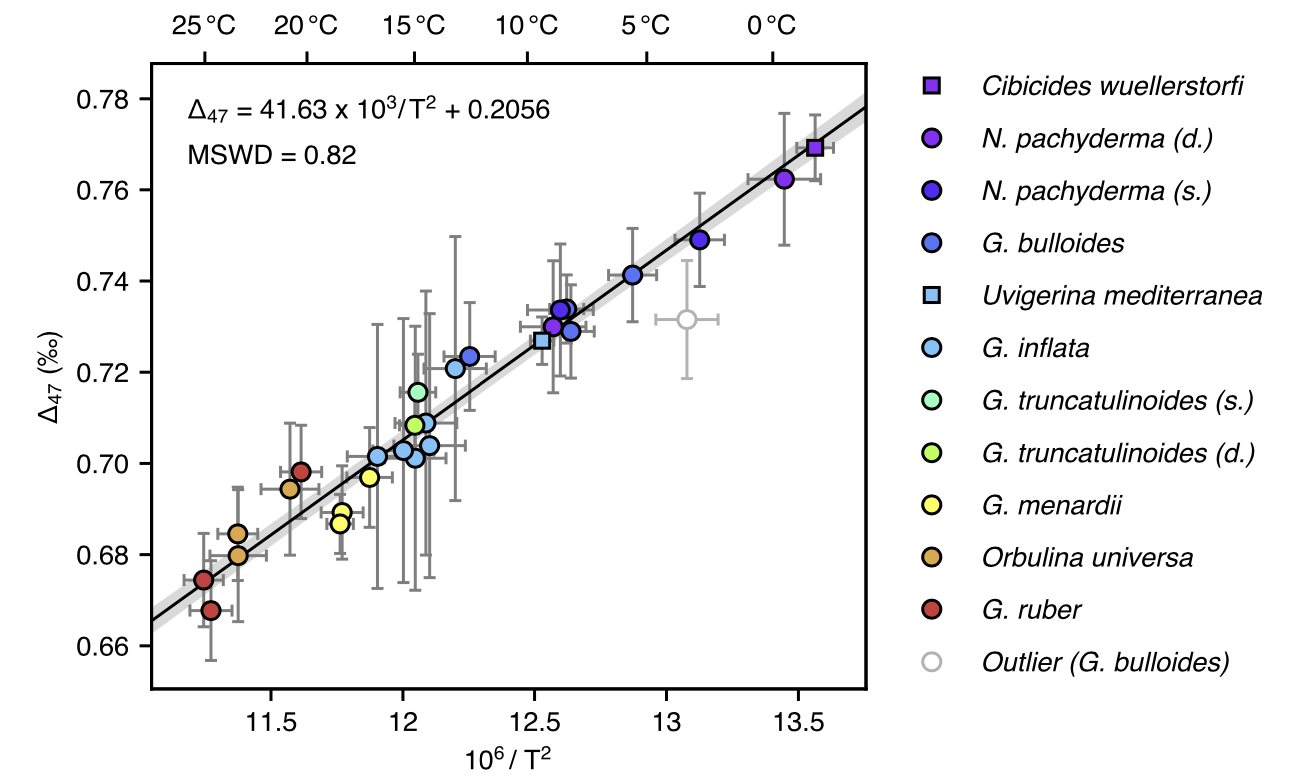Clumped-isotope in foraminifera
Foraminifera are marine micro-organisms, widely used to decipher past oceanographic and climatic changes. Foraminifera are planktonic (living in the first hundred meters in the column water) or benthic organisms (living at the interface between water and sediment or in the first centimetres in the sediment), found in all kinds of marine environments. Most foraminifer shells are made of calcium carbonate (CaCO3), mostly calcite although a few species are aragonitic. The isotopic composition of these shells may thus be used to reconstruct sea surface and bottom water temperatures.

Over the past decade, a number of calibration studies have investigated the relationship between ∆47 and temperature in biogenic carbonates such as corals, otoliths, brachiopods, molluscs, foraminifera and coccoliths (Ghosh et al., 2006; Tripati et al., 2010; Thiagarajan et al., 2011; Zaarur et al., 2011; Eagle et al., 2013; Grauel et al., 2013; Came et al., 2014; Douglas et al., 2014; Wacker et al., 2014; Katz et al., 2017). Only two of them specifically focus on foraminifera: the finding by Tripati et al. (2010) that different foraminiferal species appear to follow a single relationship between temperature and ∆47 was subsequently confirmed by Grauel et al. (2013). These early calibration studies produced a significant body of observations whose importance should not be understated. However, both of them predate substantial methodological advances in the field of clumped isotope measurements, namely the definition by Dennis et al. (2011) of an "absolute" reference frame anchored to theoretical equilibrium Δ47 values in CO2, and the systematic distribution of inter-laboratory carbonate standards. As a result, using these early observations to precisely reconstruct past seawater temperatures is not straightforward.
During my PhD, I investigated the relationship between the ∆47 values of foraminifera and calcification temperatures using samples collected in core-tops from different oceanic basins, yielding a robust calibration for temperatures ranging from -2 °C to 25 °C, that are relevant to paleoceanographic studies (Peral et al., 2018). Based on the study of 9 planktonic and 2 benthic foraminiferal species chosen among the most commonly used in paleoclimatology, these results confirm the absence of statistically significant species and salinity effects, so that ∆47 values in planktonic and benthic foraminifera seem to be exclusively determined by temperature. The findings also highlight no evidence for detectable size effects on ∆47 over a wide range of sizes in 6 species of planktonic and benthic foraminifera, suggesting that it is possible to combine foraminifera of different size fractions, which should result in notable gains in picking time, total number of analytical replicates and, ultimately, final paleotemperature precision.
Following the publication of these significant results, the calibration was confirmed by other laboratory studies on foraminifera (Piasecki et al., 2019; Meinicke et al., 2020) and various types of carbonate (e.g. Anderson et al., submitted).
Recommandations to measure clumped isotope in foraminifera:
- Sample pre-treatment:
Foraminifer
shells are cleaned to eliminate organic and detrital contaminants. The recommended cleaning procedures for foraminifer clumped isotope measures require the
following initial steps:
- Gently crush foraminifera between two glass slides to open all chambers
- Rinse the foraminifer fragments at least twice with ultrapure water in an ultrasonic bath for one minute (repeat if necessary, until the water remains clear and colourless);
- Rinse twice with reagent-grade methanol in an ultrasonic bath for 30 seconds.
It is advised to avoid the potentially destructive oxidative step with H2O2 because Scanning Electron Microscopy (SEM) images show visible dissolution and recrystallization features to the shell fragments using H2O2 treatment (picture below. More details, in my PhD or in Peral et al., 2018).

- Standardisation procedures:
- International carbonate standard: ETH 1, 2, 3, 4 (Meckler et al., 2014; Bernasconi et al., 2018; Kocken et al., 2019), IAEA-C1, 2. Values: Bernasconi et al., 2021
- Data processing and propagation errors corrections (Dennis et al., 2006; Daëron et al., 2016; Daëron et al., 2021)

